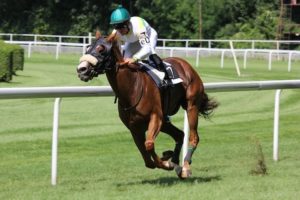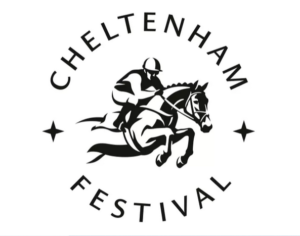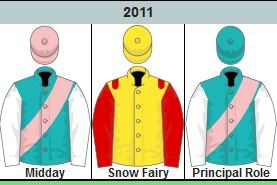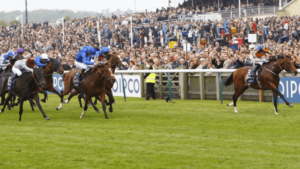How can you tell if a horse acts on soft going?
 The state of the ground, or going, on a racecourse is often a determining factor in where, when and how well racehorses run. Soft going is deep, moist and slightly muddy, thereby presenting a challenge that some horses relish, but others absolutely detest. However, there are several ways you can tell, or least make an educated guess, that a horse acts on soft going. In order of efficacy, they are its previous performances on the racecourse, its pedigree, its confirmation and gait and, last, but by no means least, the size of its feet!
The state of the ground, or going, on a racecourse is often a determining factor in where, when and how well racehorses run. Soft going is deep, moist and slightly muddy, thereby presenting a challenge that some horses relish, but others absolutely detest. However, there are several ways you can tell, or least make an educated guess, that a horse acts on soft going. In order of efficacy, they are its previous performances on the racecourse, its pedigree, its confirmation and gait and, last, but by no means least, the size of its feet!
If a horse has already raced, preferably more than once, on soft going, you can probably assess its going preference by reference to its previous form in, say, the ‘Racing Post’, or learned commentary, such as that provided by Timeform. If it hasn’t, you can only really speculate, but there are still one or two pointers that can help predict preference for one type of going or another.
Going preference tends to be inherent, so analysing the pedigree of the horse will reveal if it was sired by a stallion, such as Lope De Vega or Pivotal, whose progeny prefer soft ground. If you are able to see the horse in motion, concentrate on its knee action. Conventional wisdom suggests that horses with a high, rounded knee action naturally lift their feet up and out of the ground on each stride, so are more effective on soft going than those with a low, ‘daisy cutter’ action. Likewise, horses with larger, ‘soup plate’ hooves tend not to sink as far into soft going as those that don’t – think of a man wearing snowshoes – so waste less time and effort pulling their feet out of the ground.
 Owned by Brian Kearney, trained by Jessica Harrington, in Moone, Co. Kildare and ridden, in all bar six of his 44 races, by Barry Geraghty, Moscow Flyer was an outstanding two-mile steeplechaser in the years following the turn of the millennium. The son of Moscow Society, from the family of Nijinsky, was no slouch over hurdles, winning seven of his 12 starts over the smaller obstacles, including three at Grade 1 level. Nevertheless, it was over fences that Moscow Flyer became what his trainer described as a ‘once in a lifetime horse’, winning 19 of his 28 steeplechases, including 10 at Grade 1 level, and just over £1 million in prize money in that sphere alone.
Owned by Brian Kearney, trained by Jessica Harrington, in Moone, Co. Kildare and ridden, in all bar six of his 44 races, by Barry Geraghty, Moscow Flyer was an outstanding two-mile steeplechaser in the years following the turn of the millennium. The son of Moscow Society, from the family of Nijinsky, was no slouch over hurdles, winning seven of his 12 starts over the smaller obstacles, including three at Grade 1 level. Nevertheless, it was over fences that Moscow Flyer became what his trainer described as a ‘once in a lifetime horse’, winning 19 of his 28 steeplechases, including 10 at Grade 1 level, and just over £1 million in prize money in that sphere alone. Established in 1840, the Nassau Stakes was named by Charles Gordon Lennox, Fifth Duke of Richmond, to reflect his close ties with the House of Orange-Nassau, which survives today as the Royal House of the Netherlands. Elevated to Group 1 status in 1999, the race is run over 1 mile, 1 furlong and 197 yards at Goodwood and is open to fillies and mares aged three years and upwards. It is currently scheduled as the feature race on day three of the five-day Qatar Goodwood Festival, staged annually in late July or early August.
Established in 1840, the Nassau Stakes was named by Charles Gordon Lennox, Fifth Duke of Richmond, to reflect his close ties with the House of Orange-Nassau, which survives today as the Royal House of the Netherlands. Elevated to Group 1 status in 1999, the race is run over 1 mile, 1 furlong and 197 yards at Goodwood and is open to fillies and mares aged three years and upwards. It is currently scheduled as the feature race on day three of the five-day Qatar Goodwood Festival, staged annually in late July or early August. Nowadays, the first two Classics of the season, the 2,000 and 1,000 Guineas, are staged on the Saturday and Sunday of the Guineas Festival at Newmarket in late April or early May. The 2,000 Guineas, which is open to three-year-old colts and fillies, was established by the Jockey Club on April 18, 1809. The 1,000 Guineas, which is restricted to three-year-old fillies, followed five years later on April 28, 1814.
Nowadays, the first two Classics of the season, the 2,000 and 1,000 Guineas, are staged on the Saturday and Sunday of the Guineas Festival at Newmarket in late April or early May. The 2,000 Guineas, which is open to three-year-old colts and fillies, was established by the Jockey Club on April 18, 1809. The 1,000 Guineas, which is restricted to three-year-old fillies, followed five years later on April 28, 1814.